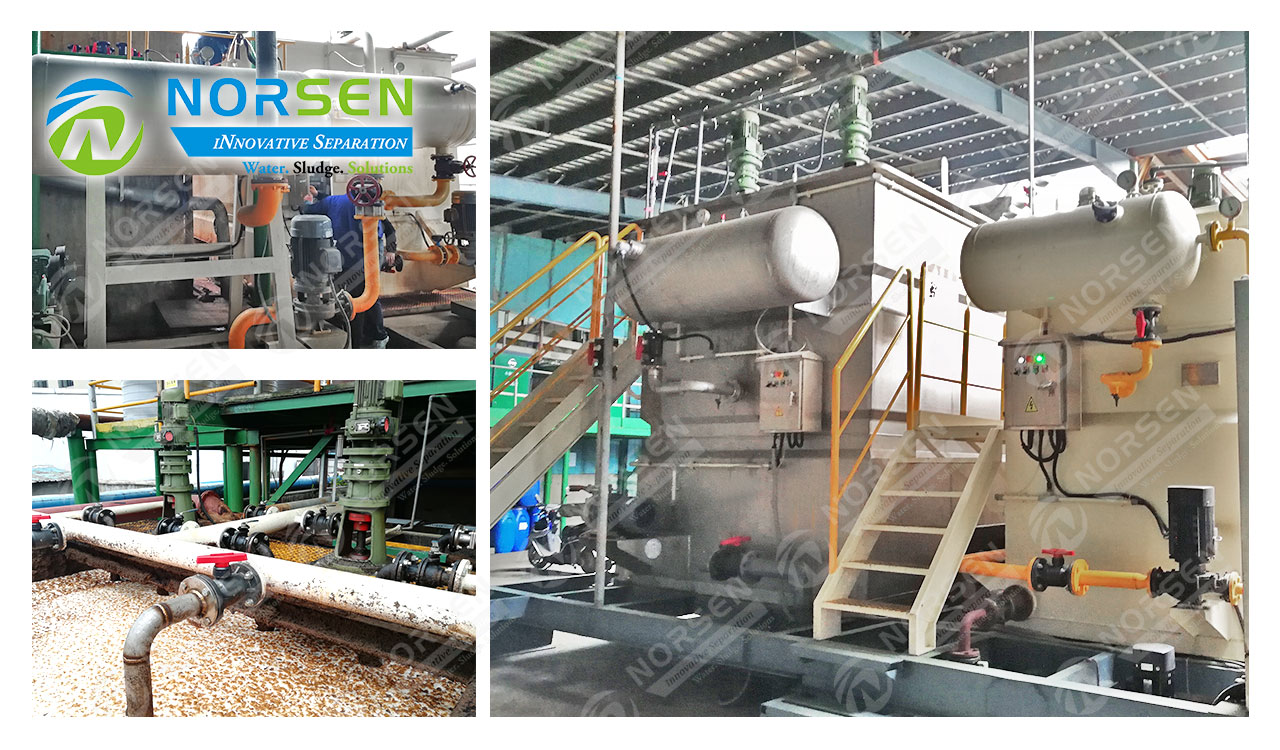- Multi-Disc Screw Press
- Dissolved Air Flotation
- Pretreatment Screens
- Lamella Clarifier
- Sludge Treatment
- Aeration
- MBBR
Office Add:Union Building 11 floor, 8th industrial street, Wuxi, Jiangsu, China
Factory Add:Xibei H-Tech Park Wuxi Jiangsu China
Tel: 0086 138 1256 5699
E-mail: jenny@norsenep.com;sales@norsenep.com
Sewage treatment effect by dissolved air flotation
Poster:Norsen │ Time:2021-09-08
Factors of influencing effect by dissolved air flotation The air flotation effect of the air flotation machine is very important to the effluent water quality. To get a good effluent effect, it is necessary to understand the air flotation process and fully understand the factors that can cause changes in the effluent water quality.

1. Influent water quality and suspended solids concentrationThe quality of the influent water is the primary factor that affects the effect of the air flotation machine. The quality of the influent water determines the type of chemical dosing, the flocculation effect after the dosing, and the dosage of the chemical. The higher the suspended matter, the longer the residence time of the air flotation machine.
2. The amount of sewage The amount of sewage is very important to the treatment effect. The dissolved air flotation machine must ensure uniform water distribution in the air flotation tank. The change of flow means the change of the amount of pollutants. It is necessary to adjust the water volume or the dosage of chemicals in time to achieve good results. When the sewage flow is too large, the horizontal flow rate of the air flotation tank is increased, and the residence time is shortened, which is unfavorable for the floating and separation of flocs; excessive flow rate will cause excessive turbulence of the water flow in the separation zone and cause the foam-floc combination to break. When the water volume is too large, the height of the outlet weir should be adjusted in time to prevent sewage from entering the scum system. In order to solve the problem of uneven water intake of the air flotation machine, an adjustment pool is set at the front end of the air flotation machine to achieve the effect of adjusting the water volume and water quality, and prevent excessive changes in the water volume and water quality from affecting the treatment effect of the air flotation machine.
3. The influence of flocculant and pH value on air flotation effect Generally speaking, the higher the concentration of suspended solids in the raw water, the more doses of medicine need to be added. For the occurrence of flocculation, there is a dosage. When this amount is exceeded, the flocculation effect will decrease, and if it exceeds this amount, it will have the opposite protective effect. In addition, it is necessary to pay attention to the proportion and order of dosage. Coagulants (such as PAC) can break the hydrophobic groups during the hydrolysis process, flocculate suspended solids and oils, and at the same time make partially dissolved proteins precipitate out in the form of small particles. The flocculant PAM has a large molecular weight and has the functions of adsorption, bridging and coupling, and sweeping. It makes the small particles initially formed under the action of the coagulant adsorb and connect to each other, thereby forming a large floc that is quickly separated from the water. In this way, under the joint action of PAC and PAM, larger flocs are formed, and the wastewater needs to be added with PAC beforehand and then with PAM. The currently used flocculant PAM is mostly acid flocculant, which has a suitable pH value. When the pH value of the sewage exceeds the appropriate pH value, it will cause the dissolution or fragmentation of the flocs, which will have a considerable adverse effect on the air flotation separation of the dissolved air flotation machine. Therefore, during operation, the pH value of influent water should be monitored and controlled.
Tags: sewage treatment, dissolved air flotation
- How to choose Low Temperature Sludge Dryer2021-08-12
- How to optimize biological wastewater treatment systems2021-08-18
- Modern innovative wastewater treatment solutions2021-08-21
- Screening process in the wastewater treatment process2021-08-28
- Sewage treatment effect by dissolved air flotation2021-09-08
- Solid-liquid separation equipment2021-09-12
- The uses of sludge dewatering polymer2021-09-16





















